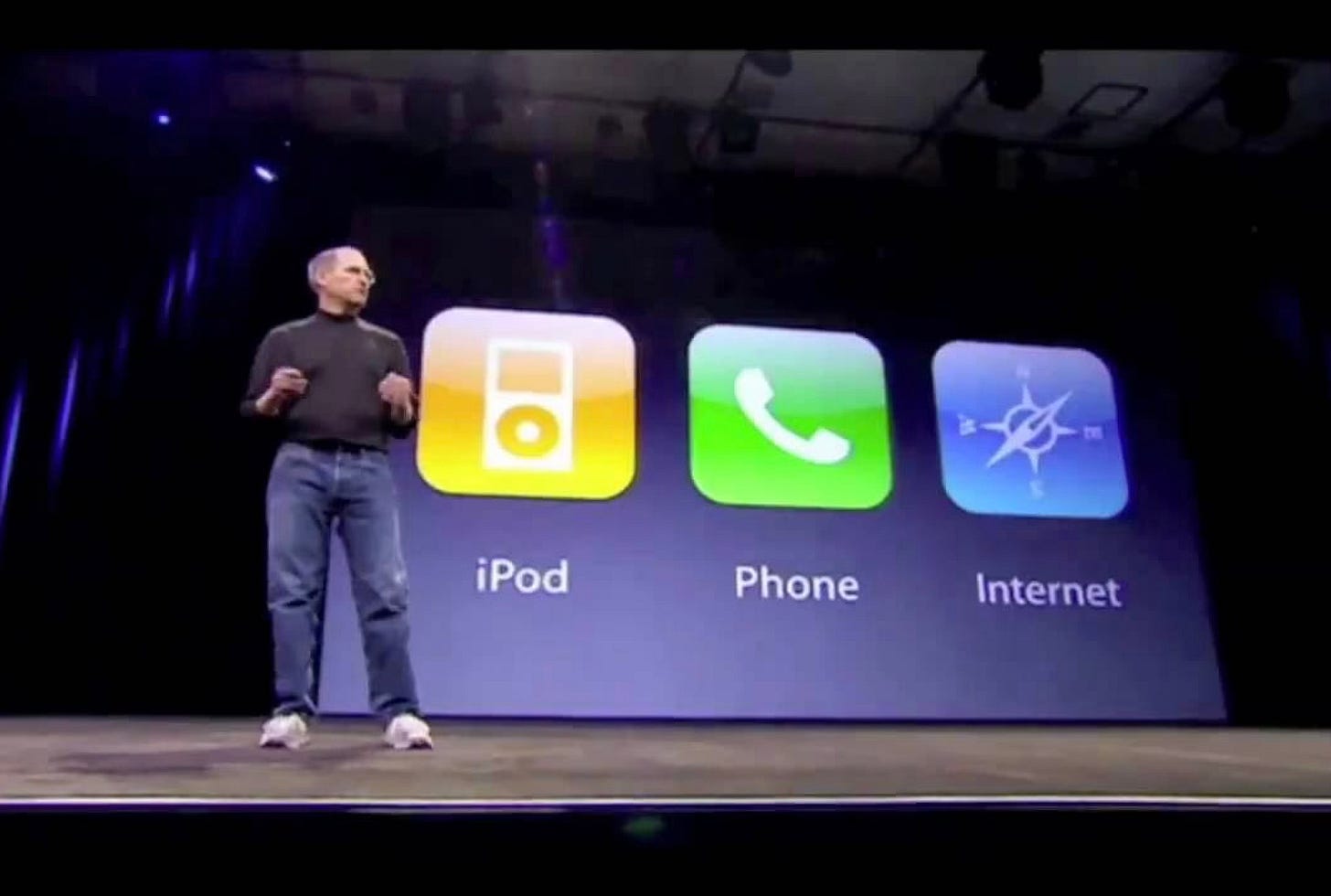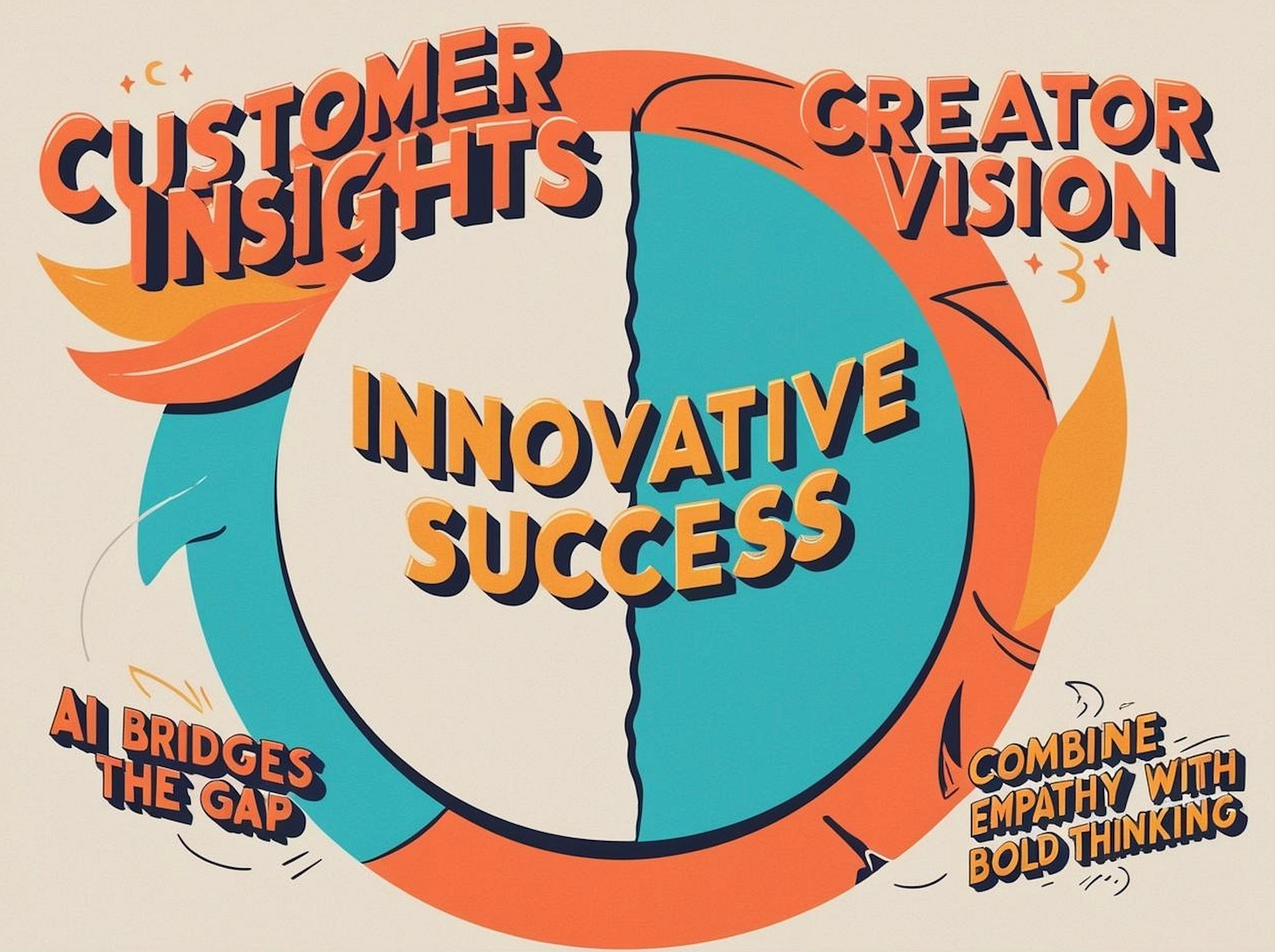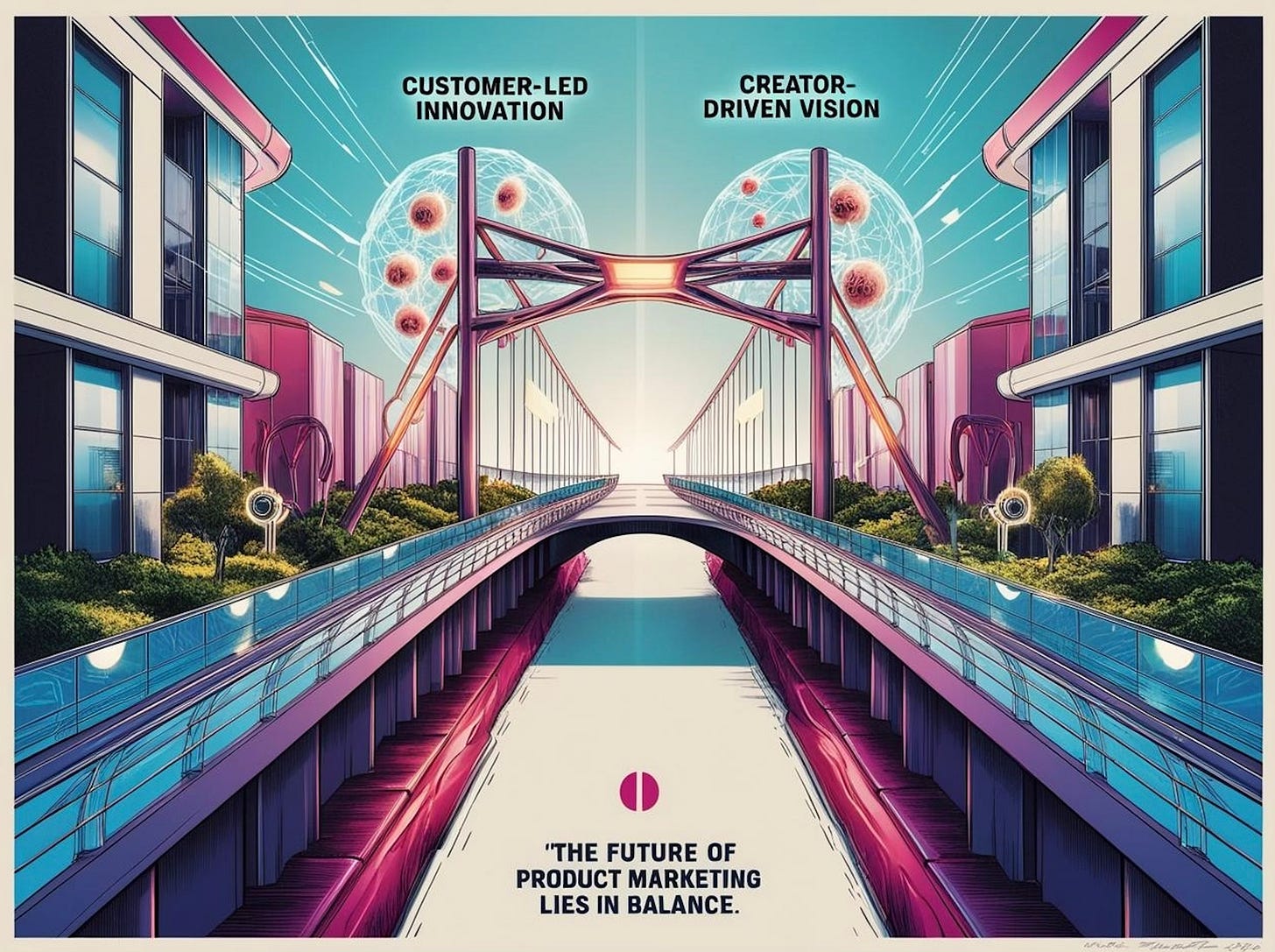Who truly drives innovation? Customers or Creators with vision?
Exploring whether the customers are the compass pointing out directions or like the history shows groundbreaking products were born from bold, visionary thinking creators.
Imagine if Steve Jobs had relied solely on customer feedback, there might never have been an iPhone. But, what if Netflix had ignored its users frustration with late fees? The streaming revolution might never have happened.
Who truly drives innovation: Customers or Visionary Creators?
It’s a debate that has shaped product marketing strategies for decades.
On one side, marketing leaders argue that customers are the best judges of what they need. They advocate for close collaboration to identify pain points, issues, and opportunities for innovation.
On the other side, there's a belief that customers don't always know what they want, especially for breakthrough innovations, and until they’re shown something extraordinary. Leaders argue that creators must envision the solution and lead customers to adopt it, placing themselves in the drivers seat.
Today, advancements in AI and data analytics add a new layer to this discussion. AI doesn’t take sides but accelerates both approaches, making customer insights sharper and creator-driven innovations smarter.
This article explores both perspectives, highlights insights from visionary leaders, and offers actionable steps to blend these approaches for unparalleled success.
The Case for Customer-Led Innovation
Listening Beyond Words
Customers are often the best source for identifying problems and gaps in the market. But they may not always articulate their needs clearly. This is where product marketers shine deciphering feedback and identifying the underlying pain points.
Co-creation fosters stronger customer loyalty and a sense of ownership.
Example:
LEGO's Ideas platform taps into fan creativity by allowing customers to propose new designs. This approach gave rise to hits like the LEGO Women of NASA set, which resonated deeply with their audience and became a bestseller. Listening isn’t just about addressing needs, it’s about fostering emotional connection.
How AI Accelerates Customer Insights
AI enables product marketers to listen at scale, making customer feedback more actionable and insightful than ever before. Here’s how:
Social Listening: Tools like Brandwatch and Sprout Social analyze conversations across platforms to identify trends and hidden frustrations.
Behavioral Analytics: Platforms like Hotjar and Google Analytics track digital behavior, uncovering friction points customers may not even realize exist.
Sentiment Analysis: Natural Language Processing (NLP) tools extract emotions from customer reviews, offering deeper insights into how customers feel about products.
Spotify doesn’t just rely on users to request playlists. It uses AI-powered mood analysis to created curated playlists like “Chill Vibes” or “Morning Motivation”, anticipating emotional needs customers haven’t expressed explicitly.
What are your customers not telling you that their actions might reveal?
Metrics to Track:
Net Promoter Score (NPS): Measures customer loyalty and likelihood to recommend your product.
Churn Rate Analysis: Identifies when and why customers leave, helping you address unmet needs proactively.
Conversion Funnels: Pinpoints drop-off points where customers face friction.
Potential pitfalls:
Customers might focus on incremental improvements rather than envisioning revolutionary solutions.
Listen deeply to customers, but use their inputs to understand problems, not just solutions. Your role as a product marketer is to uncover insights behind the feedback, rather than taking it a face value.
What do you think?
Sundar Pichai, CEO of Google, champions customer-centric thinking, emphasizing the importance of building products that billions of people use daily. This underscores the value of listening to the market while scaling globally.
The Case for Creator-Driven Innovation
Boldly Leading the Market
Great innovations often emerge not from customer demand but from visionary creators who anticipate what customers will want in the future. Customers may focus on incremental changes, but creators think beyond current constraints. On the flip side history is full of examples where creators boldly led innovations, paving the way for transformative products.
Focus on challenging the status quo and reshaping industries
Example:
Consider Apple’s iPhone launch in 2007. Did customers ask for a smartphone that combined music, internet, and phone functionality? No. Apple anticipated what people didn’t realize they needed and showed the world a new way to live digitally.
Tesla’s electric cars weren’t the result of customer surveys. Instead, Elon Musk envisioned a future where sustainable energy and performance coexisted. By investing in bold ideas like autopilot and battery innovation, Tesla reshaped the automotive industry.
Steve Jobs famously remarked, "Some people say, give customers what they want, but that’s not my approach. Our job is to figure out what [customers] are going to want before they do." Apple’s iPhone was not requested by customers, it was created because Jobs believed in a future where technology would seamlessly integrate into daily life.
How AI Enhances Creator-Driven Innovation
AI helps creators test, validate, and refine visionary ideas with unprecedented speed and accuracy:
Predictive Analytics: Tools like Tableau and Power BI forecast demand for new product categories, helping creators prioritize bold concepts.
Simulation Models: Digital twins allow creators to simulate real-world scenarios, refining ideas before full-scale production.
AI Prototyping: Platforms like Runway AI and OpenAI’s Codex accelerate concept development, from UI mockups to functional product features.
Tesla’s autopilot feature wasn’t born out of customer requests but from Elon Musk’s vision of autonomous driving. AI and predictive modeling helped Tesla simulate scenarios and refine their AI-based driving systems, enabling them to stay ahead of competition.
What if your next big idea isn’t just disruptive, but emotionally irresistible?
Metrics to Track:
Time-to-Market: How quickly can bold ideas move from concept to launch?
Market Penetration Rates: How well do new products capture attention and adoption?
Innovation ROI: Are visionary products driving long-term business growth?
Customer Lifetime Value (CLV): Are innovations enhancing long-term customer relationships?
Potential pitfalls:
Risk of creating solutions that customers may not adopt if they don’t see the immediate value.
Misalignment with real-world needs can lead to costly failures (e.g., Google Glass is great example of creator driven innovation that failed. The product was innovative, but its lack of alignment with customer readiness and practical use made it flop).
As a product marketer, challenge yourself to think beyond the obvious. Use customer insights to shape your vision but don’t let them limit your creativity. Sometimes, showing customers what’s possible is the key to success. But the visionary approach isn’t without the risk
What do you think?
Striking the Balance: The Hybrid Approach
Advocate for a “Customer informed, Creator-led strategy”
The truth is, great product marketing lies at the intersection of these two approaches. AI plays a pivotal role in bridging customer insights with creator-led vision, creating a hybrid model that’s both empathetic and innovative.
Leverage customer insights to understand the problem deeply but take the lead in envisioning and shaping solutions
Practical Steps to Blend the Two
Start with Customer Empathy: Use sentiment analysis and behavioral data to identify pain points that matter most to your audience.
Think Boldly: Layer predictive analytics onto customer insights to explore new solutions beyond what’s currently imaginable.
Validate Quickly: Use tools like Optimizely for rapid A/B testing, ensuring visionary ideas align with market readiness.
Iterate Continuously: Combine customer feedback loops with AI-driven refinements to evolve your products over time.
Example:
Netflix seamlessly combines both approaches. Initially solving a clear customer pain point (late fees on DVDs), they later introduced streaming, a bold, creator-driven innovation. Today, they use AI to personalize content recommendations, blending customer satisfaction with visionary thinking.
Dyson, whose vacuum cleaners weren’t just created based on customer complaints about traditional vacuums. Dyson reimagined the category with bagless technology and sleek designs, while addressing the core pain points like suction and convenience.
Duolingo uses customer feedback to address frustrations (e.g. gamifying language learning) but also incorporates AI to personalize learning journeys, creating solutions customers didn’t even know possible
Such companies succeeded because they combined emotional intelligence (understanding customer pain) with bold innovation (pushing boundaries)
Start with empathy, understand your customers pain points and emotional drivers. Then innovate with vision and conviction. Test your ideas iteratively, allowing customer feedback to refine bold concepts.
What do you think?
What Visionary Leaders Say About Innovation
Here’s what some of the world’s top leaders have said about this debate:
Steve Jobs (Apple): "Customers don’t know what they want until we’ve shown them." Jobs emphasized the role of creators in envisioning solutions customers hadn’t imagined.
Elon Musk (Tesla, SpaceX): "Pay attention to negative feedback, and solicit it, particularly from friends" Musk values critical input while championing bold, creator-led innovation.
Jensen Huang (NVIDIA): "Believe in something unconventional, something unexplored." Huang highlights the importance of pursuing groundbreaking ideas, even without customer validation.
Sundar Pichai (Google): "We try to work on things billions of people will use every day." Pichai focuses on scaling solutions that impact global audiences.
Henry Ford (Ford Motor Company): "If I had asked people what they wanted, they would have said faster horses." Ford’s classic quote reminds us that visionary creators often see beyond customer-imposed limits.
Marketing with Emotional Intelligence
Beyond tools and strategies, the most successful product marketers bring emotional intelligence (EQ) into the mix:
Empathy: Understand your customers’ unspoken fears and aspirations.
Storytelling: Craft narratives that emotionally connect your product with customer needs. Bridge the gap in story telling.
Adaptability: Stay attuned to evolving market dynamics and pivot when necessary.
AI tools can analyze customers emotions using sentiment analysis, but it’s up to us to interpret those insights and connect them to real human needs.
Example:
Nike’s marketing embodies emotional intelligence by tapping into universal human emotions like resilience, ambition, and determination. During the global pandemic, Nike launched its “You can’t stop us” campaign, bending real customer satires with an uplifting message of perseverance.
How emotional intelligence played a role?
Nike didn't focus on selling shoes, instead, they showcased the struggles and triumphs of athletes and everyday people adopting to adversity. The ad united audience emotionally, reinforcing Nike’s brand values of empowerment and inclusivity that connected with everyone.
Use AI to enhance your EQ-driven story telling. Build customer personas based on emotional drivers and align your product messaging with their aspirations and fears.
Conclusion
The debate between customer-led and creator-driven innovation isn’t about choosing sides, it’s about finding the right balance. AI accelerates both approaches, empowering product marketers to listen more deeply, innovate more boldly, and execute with greater precision.
As Steve Jobs said, "Our job is to figure out what customers are going to want before they do." By combining empathy, data-driven insights, and visionary thinking, product marketers can create solutions that not only solve problems but inspire change.
So, the next time this debate comes up in a meeting, ask yourself: It’s not about choosing one over the other, how can I use the tools at my disposal to integrate both approaches and drive innovation that truly resonates, inspires, and build lasting connections?
And that’s how great product marketing happens.
Let me know what you think?
Useful links for some of the source for the articles:
https://mitsloan.mit.edu/ideas-made-to-matter/googles-sundar-pichai-says-tech-a-powerful-agent-change
https://www.adweek.com/performance-marketing/elon-musk-pay-attention-to-negative-feedback-and-solicit-it-particularly-from-friends/
https://blogs.nvidia.com/blog/jensen-huang-caltech-commencement-address/#:~:text=NVIDIA%20founder%20and%20CEO%20Jensen,Something%20unconventional%2C%20something%20unexplored.
https://www.india.com/webstories/business/7-life-changing-quotes-from-google-ceo-sundar-pichai-7268120/













